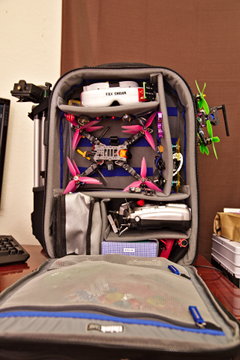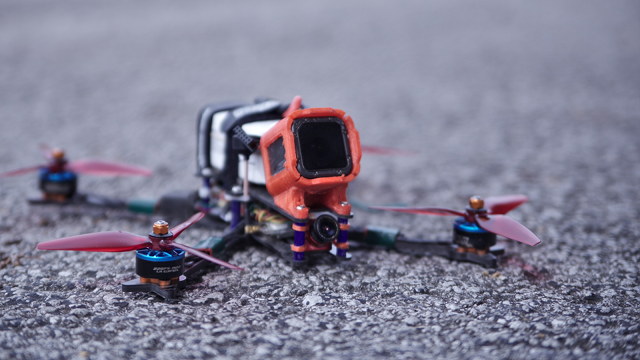Not too long ago, DJI released a new digital video-transmission system for FPV miniquad pilots. I’ve been keeping an eye on it. I’ve been watching videos. I’ve been listening to what people say. I’ve been trying to figure out if this is a system that I’m going to want to buy into.
I am not going to be buying into DJI’s ecosystem at this time. DJI’s new system has a lot going for it, especially if you’re a brand new pilot and haven’t already invested in analog gear.
I’m going to do my best to explain why DJI’s FPV system isn’t for me. I’m going to start with problems that are easy to measure, then work my way towards the less concrete things.
- The DJI Digital FPV System at dji.com
The DJI FPV Air Unit is too big
The Air Unit is the box of electronics and the FPV camera that sit on your miniquad. It is just too big, and in some cases, much too heavy.
It won’t fit nicely into any of my existing freestyle frames. To be honest, this is a minor complaint. I’m cutting my own frames now anyway. Correcting this problem would just involve cutting new bottom and top plates for two or three of my quads.
I recorded my impression of flying the Betaflight 4.1 RPM filter for the first time! pic.twitter.com/yiYxsEP98R
— Pat Regan (@patsheadcom) September 26, 2019
If you’re not me, you might have to buy new frames. You’ll probably be spending $50 to $100 per frame, right?
The Air Unit weighs about 45 grams. That extra 20 to 30 grams or so compared to my existing VTX and camera won’t be a big deal on my 5” freestyle miniquads, but what about my 3” and 4” sub-250 gram Kestrel builds? My camera and VTX combination on my micros is already lighter than what I use on my 5” rigs, so the Air Unit might add even more weight.
The current size and weight of the Air Unit make it unusable for my 3” and 4” builds.
I fully expect DJI to miniaturize this hardware. When they do, I will have to revisit this topic!
Even if they do miniaturize the Air Unit, we’re not going to see it on whoops or toothpicks any time soon. This brings me to my next problem.
I don’t want to carry two sets of goggles
My ThinkTank backpack is huge, but it is already more than full. I’d have to rearrange everything just to fit the larger DJI goggles in place of my Fat Shark goggles. I definitely don’t want to have to find a way to squeeze both sets of goggles in there!
My goal is to fit everything I need for a day out flying in my bag, so it is already packed pretty tight!
Can’t you plug an analog receiver into the DJI goggles?
Yes. Sort of. There is a way to make this happen, but you have to modify the goggles a bit. I think this will be a fantastic option for people that buy into DJI’s system. You can fly your nice, big, expensive quads with your digital link. Then you can still fly a TinyHawk around the house with an analog receiver.
So far, I haven’t heard any good things about using the analog input on the DJI goggles. Maybe this will get better with a firmware update, but it sounds like for the time being, using the DJI goggles to fly an analog quad isn’t a great experience.

The weird analog feed to the DJI goggles might be good enough for playing around with a TinyHawk around the house, but I don’t want to use it with my HD micro freestyle builds.
Don’t you want HD video, Pat?!
My impression so far is that DJI’s HD video feed isn’t a straight-up upgrade over what I have today. Some things are greatly improved. Other aspects, not so much.
It is absolutely amazing that you can get eight pilots in the air at once, and they all have amazing video feeds. When you have good signal, the picture is clear.
I have some concerns about the dynamic range and the speed of the DJI camera’s transition from light to dark.
I flew in my first drone race last night. I forgot to DVR most of it, but I did fly my freestyle quad with its GoPro the entire night. I'm pretty sure this was my fastest lap of the night at just over 42 seconds. If I shave off 26 seconds, maybe I can catch @captainvanover? pic.twitter.com/nz3ozo9oBO
— Pat Regan (@patsheadcom) September 29, 2019
NOTE: That’s my GoPro HERO5 Session going around the track!
My Runcam Eagle Micro sometimes looks like I’m flying in an oversaturated cartoon landscape, but I can usually see my friend walking in the shade under dense trees. When I’m flying through a parking garage, I can see shapes in the sun outside instead of just blown-out highlights.
Maybe I’m worried over nothing. Maybe if I could fit the DJI Air Unit on my 3” builds, I would ignore this concern completely!
What about the DJI system’s range?
I can’t make up my mind here. We’ve seen Le Drib fly his DJI system inside a building where his analog setup was barely working. We also hear about it randomly dropping out when analog would be fine.
In other words, DJI’s range and overall performance isn’t a straight-up upgrade over what I’m already flying. Sure, it has plenty of improvements, but I still keep seeing the drawbacks. In some situations, the DJI gear outperforms my analog gear. In some situations, my analog gear can do better. In most situations, the only thing I’m giving up is the more detailed HD image.
- DJI FPV at the Bando! on YouTube
Price isn’t the problem
I absolutely adore my TBS Crossfire. Knowing that my control link is absolutely rock solid makes me so much more confident. If you’re a new pilot, though, and you’re planning to use DJI’s control link, then the DJI system’s price compares quite favorably to analog.
The DJI FPV Experience Combo costs about $1,000 and comes with goggles, a controller, and enough Air Units and antennas for two quads.

If you add up Fat Shark HDO goggles ($500), a RapidFire module ($160), a Taranis Q X7 ($105), a Crossfire Micro TX module ($70), two Crossfire Nano RX modules ($35 x 2), and a pair of RaceDayQuads VTX modules ($25 x 2), you’ll end up at $955.
As you build more quads, the analog pricing starts to look better, but not by a ridiculous margin. However, that top of the line analog system I listed isn’t the only option. You can spend half as much on the goggles and video receiver, and you can completely skip the Crossfire stuff. That wouldn’t be as fair a comparison, though.
One important thing to note here is that you can buy into our old analog video system on a budget. Sure, top-of-the-line analog hardware is comparable in price to the DJI FPV system. The goggles I run cost $200 less than the Fat Shark HDO goggles. I’d bet you could get a pretty nice analog setup for half the price, and entry-level hardware can be had for 10% of the price of the DJI setup.
If they cost the same, why buy into analog today?
Your friends are already flying analog. When I went to a MultiGP race for the first time last month, every single pilot was flying analog. These were all people I hadn’t met before, and I could tune in to any of their video feeds to spectate.
When I go flying with my friends, I can tune in to their flights, and they can tune in to mine. They can give me pointers. I can praise them when I see them pull off a neat maneuver. We can all hoot and holler when we see a spectacular crash!

I’d hate to be the one person in the group using DJI goggles, especially if I’m new to the hobby. If your quad is doing something funny when you yaw 180 degrees, I might need to see it happen through the goggles to help you out. Maybe it doesn’t happen when I fly your quad because the problem is something the pilot is doing.
This alone is enough reason for me to still recommend analog today. For me, FPV is about community. I’d hate to be the one guy out there doing it alone!
DJI FPV goggles aren’t compatible with DJI’s photography drones
What?! This surprised me quite a bit when the system was released. If you told me that I can carry one set of goggles and use it with my FPV miniquads AND a Mavic 2, it would be amazing. I’d go right out and buy a Mavic!
The FPV goggles aren’t compatible. They’re two very different video protocols. Isn’t that a bummer?
Maybe DJI’s products will converge in a few years!
What about Fat Shark Byte Frost?!
I had high hopes for Byte Frost. The video transmitter board is just a standard 30x30 board that will fit right in your stack. I can even fit that in my 3” Kestrel, and it isn’t nearly as heavy as the DJI Air Unit!
Unfortunately, Byte Frost just doesn’t look like it can compete with DJI. In Joshua Bardwell’s test, Byte Frost’s range with directional patch antennas was worse than DJI’s range with omni antennas.
Byte Frost seems to only support four quads at a time, while we’ve all seen DJI’s system allow 8 pilots to fly simultaneously.
That said, it is my understanding that Byte Frost has low, consistent latency. When your signal gets weak, the DJI system’s latency increases and the quality drops. When the Byte Frost signal gets weak, it seems to start dropping bits of the picture, but the latency stays low.
Even though it has a couple significant advantages over the DJI FPV system, I don’t believe things look good for Byte Frost at this point.
Conclusion
Maybe you don’t care about having to carry two sets of goggles. Maybe your entire fleet can carry a DJI Air Unit. Maybe the DJI FPV system is a good fit for you.
It just isn’t a good fit for me, and I bet that’s true for most of you folks, too. Electronics always get smaller and cheaper. I have hopes that the next revision of DJI’s FPV system will be a better fit for more of my fleet, and the revision after that will likely be even better! It doesn’t have to fit on my whoops. If DJI can cover my 3”, 5”, and larger quads, I would feel comfortable leaving my Fat Sharks at home!
What do you think? Are you excited about DJI’s digital video quality? Do you want to fly with a feed that looks more like a GoPro? Or do you think that the community of spectators is still more important? Let me know what you think in the comments, or stop by the Butter, What?! Discord server to chat with me about it!
